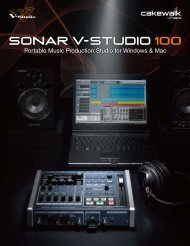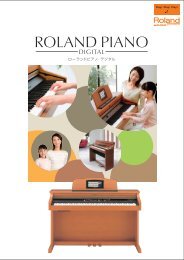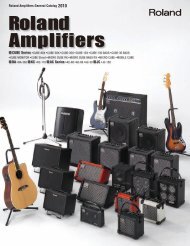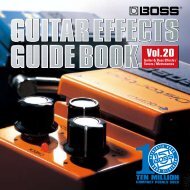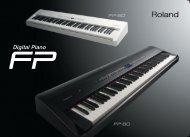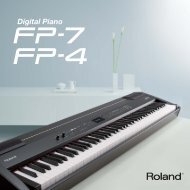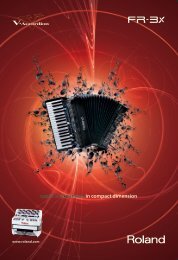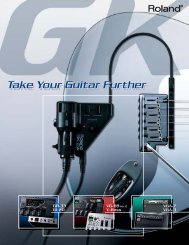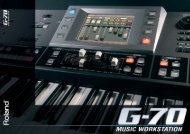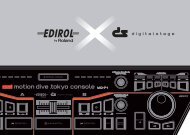Roland Digital Accordions. The tradition outside. The future inside.
Roland Digital Accordions. The tradition outside. The future inside.
Roland Digital Accordions. The tradition outside. The future inside.
You also want an ePaper? Increase the reach of your titles
YUMPU automatically turns print PDFs into web optimized ePapers that Google loves.
he History<br />
<strong>The</strong> History<br />
Past and <strong>future</strong><br />
Around the middle of the 19th century, a new concept that involved a<br />
bellows and a free-reed mechanism was developed in Central Europe.<br />
It heralded the introduction of a totally new instrument - the acoustic<br />
accordion. Since then, its unique character, portability, and variety of<br />
sounds have made the accordion a tremendously popular instrument<br />
all over the world. Due to its complex mechanism and portability, the<br />
acoustic accordion long appeared an instrument that couldn’t be<br />
improved using digital technology.<br />
he<br />
<strong>The</strong> Technology<br />
PBM (Physical Behaviour Modelling)<br />
At the heart of the V-Accordion is <strong>Roland</strong>’s new, proprietary PBM sound<br />
engine and modelling technology. Physical Behaviour Modelling uses<br />
complex algorithms to accurately recreate an acoustic accordion’s sound<br />
characteristics. <strong>The</strong> result is a faithful simulation of the actual physical<br />
behaviour and expressive nuances of an acoustic instrument.<br />
Bellows Movement Modelling<br />
PVA (Pressure Variant Amplifi er)<br />
This function controls the dynamics of each<br />
reed sound, based on the high-resolution<br />
bellows pressure sensor. Starting and<br />
stopping, hysteresis threshold, inertia,<br />
expression curve, and volume are all<br />
individually programmed to reproduce a<br />
true free-reed sound.<br />
PVF (Pressure Variant Filter)<br />
<strong>The</strong> tone colour of each reed sound is also<br />
shaped in real-time by the dedicated DSP<br />
(<strong>Digital</strong> Signal Processor), responding<br />
M<br />
E<br />
ULOV<br />
Hysteresis Thresholds<br />
M<br />
E<br />
ULOV<br />
Expression Curve<br />
Off<br />
On<br />
Reed Inertia<br />
BELLOWS PRESSURE<br />
BELLOWS PRESSURE<br />
16’<br />
8’<br />
2’ 2/3<br />
Until <strong>Roland</strong> introduced the V-Accordion series - the fi rst instruments of<br />
their kind to provide powerful digital modelling technology in a <strong>tradition</strong>al,<br />
immediately familiar, accordion design, and with performance functions<br />
and authentic sounds that appealed to a wide range of players.<br />
accurately to each expressive playing nuance applied by the bellows.<br />
PVP (Pressure Variant Pitch)<br />
<strong>The</strong> pitch of each simulated reed is varied individually. As the bellows<br />
is pushed or pulled more forcefully, the<br />
sound becomes fatter and richer, because<br />
each simulated reed exhibits a “natural” <br />
In Tune<br />
tendency to go out of tune.<br />
Musette Tuning<br />
Based on extensive research of the<br />
different tuning types used throughout<br />
the world the V-Accordion’s note-by-note<br />
2’ 2/3<br />
8’<br />
16’<br />
BELLOWS PRESSURE<br />
micro-tuning feature allows a V-Accordion to authentically reproduce many<br />
different accordion types for various genres of music.<br />
V-Accordion<br />
Line-up<br />
Piano-type<br />
Treble Keyboard<br />
Models<br />
<strong>Roland</strong> is pleased to introduce another<br />
milestone in digital musical instrument<br />
history– the V-Accordion with pianotype<br />
treble keyboards. This line-up<br />
is the fi rst to successfully integrate<br />
cutting-edge digital technology, such<br />
as our proprietary “Physical Behaviour<br />
Modelling” (PBM), into a <strong>tradition</strong>al<br />
accordion design, offering performance<br />
features and authentic sounds perfect<br />
for a wide range of musical styles.<br />
<strong>The</strong> <strong>Roland</strong> V-Accordion series of pianotype<br />
instruments comprises 5 models<br />
and 3 colour variations: FR-7 (grey/red),<br />
FR-5 (grey/red), FR-3s (grey), FR-3<br />
(grey), and FR-3s (white).<br />
<strong>The</strong> fl agship, the FR-7, provides 41<br />
velocity-sensitive piano-type keys,<br />
aftertouch and 40 Accordion sets, and<br />
a Master bar. <strong>The</strong> FR-5 shares these<br />
features, but comes without speakers or<br />
an amplifi cation system. <strong>The</strong> lightweight<br />
and portable FR-3s and FR-3 are fi tted<br />
with 37 velocity-sensitive keys. While<br />
the FR-3s contains an onboard digital<br />
amplifi er and two speakers, the FR-3<br />
doesn’t, and is therefore the lightest<br />
member of the V-Accordion family, but<br />
just as fl exible as the FR-3s.<br />
How about treating yourself to<br />
something exclusive? With the FR-3s<br />
WHITE, you are sure to stand out from<br />
the crowd: the elegant pearl-white<br />
cabinet and gorgeously decorated<br />
bellows are complemented with highly<br />
attractive accessories (shoulder straps,<br />
bass strap cushion and bellows stop)<br />
made of real leather and Alcantara®.<br />
All V-Accordion models offer selectable<br />
Bass & Chord modes (6 modes: 2 Bass<br />
Rows, 3 Bass Rows A7th, 3 Bass Rows<br />
A5dim, 3 Bass Rows B7th, 3 Bass Rows<br />
B5dim, 3 Bass Rows Bx) and Free Bass<br />
modes (5 modes: Minor 3rd, Bajan,<br />
Fifth, N.Europe, Finnish).<br />
Alcantara® is a registered trademark of Alcantara Spa., Italy<br />
Sergio Scappini




